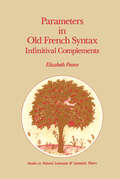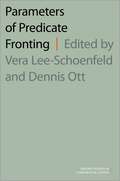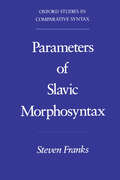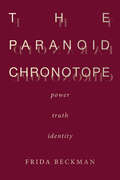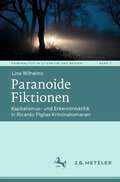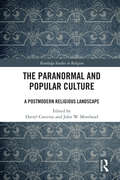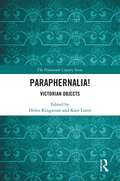- Table View
- List View
The Parameter of Aspect (Studies in Linguistics and Philosophy #43)
by C.S. SmithDuring the period I have been working on this project I have received institutional support of several kinds, for which I am most grateful. I thank the Institute for Advanced Study at Stanford University, and the Spencer Foundation, for a stimulating environment in which the basic idea of this book was developed. The Max Planck Institute for Psycholinguistics at Nijmegen enabled me to spend several months working on the the manuscript. ANational Science Foundation grant to develop Discourse Representation theory, and a grant from The University Research Institute of the University of Texas, allowed me time to pursue this project. I also thank the Center for Cognitive Science at the University of Texas for research support. I thank Helen Aristar-Dry for reading early drafts of the manuscript, Östen Dahl for penetrating remarks on a preliminary version, and my collaborator Gilbert Rappaport for relentIess comments and questions throughout. The individuals with whom I have worked on particular languages are mentioned in the relevant chapters. I owe a particular debt of gratitude to the members of my graduate seminar on aspect in the spring of 1990: they raised many questions of importance which made a real difference to the working out of the theory. I have benefitted from presenting parts of this material publicly, including cOlloquia at the University of California at Berkeley, the University of California at San Diego, the University of Pennsylvania, Rice University, the University of Texas, and the University of Tel Aviv.
The Parameter of Aspect (Studies in Linguistics and Philosophy #43)
by C.S. SmithThis work presents a unified theory of aspect within Universal Grammar. It provides an unusual combination of syntactic, semantic, and pragmatic approaches to a single domain, and gives detailed linguistic analyses of five languages with very different aspectual systems: English, French, Mandarin Chinese, Navajo and Russian. This second edition has been completely revised to include further development of the two-component theory, including new treatments of boundedness, dynamism and a general account of aspectual shifts. It includes syntactic and semantic tests.
Parameter Setting (Studies in Theoretical Psycholinguistics #4)
by Thomas RoeperIn May 1985 the University of Massachusetts held the first conference on the parameter setting model of grammar and acquisition. The conference was conceived in the belief that there is a new possibility of tightly connecting grammatical studies and language acquisition studies, and that this new possibility has grown out of the new generation of ideas about the relation of Universal Grammar to the grammar of particular languages. The papers in this volume are all concerned in one way or another with the 'parametric' model of grammar, and with its role in explaining the acquisition of language. Before summarizing the accompanying papers, I would like to sketch the intellectual background of these new ideas. It has long been the acknowledged goal of grammatical theorists to explicate the relation between the experience of the child and the knowledge of the adult. Somehow, the child selects a unique grammar (by assumption) compatible with a random partially unreliable sample of some language. In the earliest work in generative grammar, starting with Chomsky's Aspects, and extending to such works as Jackendoffs Lexicalist Syntax (1977), the model of this account was the formal evaluation metric, accompanied by a general rule writing system. The model of acquisition was the following: the child composed a grammar by writing rules in the rule writing system, under the constraint that the rules must be compatible with the data, and that the grammar must be the one most highly valued by the evaluation metric.
Parameter Setting in Language Acquisition
by Dalila AyounThis book provides a broad overview of parameter-setting theory in first and second language acquisition and refines the theory by revisiting and challenging the traditional assumptions that underlie it, based on cross-linguistic language data that cover a range of syntactic and phonological phenomena.From an historical perspective on parameter-setting theory to an introduction to its role in computational linguistics, neurolinguistics, and language change, the reader will find a critique of the most commonly made arguments, as well as an index of all the syntactic, phonological, lexical, and morphological parameters presented in the literature to date. A closer look at the theory itself addresses the following questions: What does a parameter-setting approach to language acquisition entail? What are the underpinnings of the theory? What issues and problems remain to be solved?The empirical studies carried out to test the null subject parameter and verb movement parameter are reviewed to re-examine long-standing theoretical assumptions as well as the learnability implications for first and second language acquisition.
A Parameter-Setting Model of L2 Acquisition: Experimental Studies in Anaphora (Studies in Theoretical Psycholinguistics #5)
by S. FlynnRecent developments in linguistic theory have led to an important reorientation of research in related fields of linguistic inquiry as well as in linguistics itself. The developments I have in mind, viewed from the point of view of government-binding theory, have to do with the character ization of Universal Grammar (UG) as a set of subtheories, each with its set of central principles (perhaps just one principle central to each subtheory) and parameters (perhaps just one for each principle) according to which a principle can vary between an unmarked ('-') and a marked ('+') para metric value (Chomsky, 1985; 1986). For example, let us assume that there is an X-bar theory in explanation of those features of phrase structure irreducible to other subtheo ries of UG. Within X-bar theory variation among languages is then allowed only with respect to the position the head of a phrase occupies in rela t ion to its complemen ts such that the phrases of a language will be either right- or left-headed. Thus languages will vary between being right-headed in this respect (as in Japanese phrase structure) and being left-headed (as in English phrase structure). Everything else about the phrase structure of particular languages will be fixed within X-bar theory itself or else it will fallout from other subtheories of UG: Case theory; 0-theory, etc. (Chomsky, 1985:161-62; Chomsky, 1986:2-4; and references cited there). Hatters are the same in other modules of grammar.
Parameters and Functional Heads: Essays in Comparative Syntax (Oxford Studies in Comparative Syntax)
by Adriana Belletti Luigi RizziThe essays collected in this volume, most previously unpublished, address a number of closely interconnected issues raised by the comparative syntax of functional heads within the Principles-and-Parameters approach. The general theory of head movement, the properties of derived structures created by incorporation, and the parameterization involved are the main theoretical foci. One major empirical area which is addressed concerns head movement in configurations involving certain kinds of operator-like elements, for example, the different manifestations of Verb Second phenomena in Wh and other constructions and the syntax of negative heads and specifiers. In addition, properties of functional heads and head movement in nominal and clausal structures and the causative construction are investigated.
Parameters and Universals (Oxford Studies in Comparative Syntax)
by Richard S. KayneThis is a collection of previously published essays on comparative syntax by the distinguished linguist Richard Kayne. The papers cover issues of comparative syntax as they are applied to French, Italian, and other Romance languages and dialects, together forming a strongly cohesive set that will be valuable to both scholars and students.
Parameters in Old French Syntax: Infinitival Complements (Studies in Natural Language and Linguistic Theory #18)
by E.H. Pearce1.1. AIMS AND ASSUMPTIONS This book presents an analysis of infinitival complement constructions in Old French (OF) from the perspective of the Government-Binding (GB) framework. It aims, therefore, to establish within the terms of the GB framework just how the OF constructions are to be characterized and in just what sense they can or cannot be compared with the corresponding constructions in other Romance languages. The GB framework is an articulated theory about the structure of language which is based on the view that the aim of research into language is to construct a description of language which accurately reflects its essential nature. Whilst we know that individual languages may appear to be superficially very different, we also know that all languages are capable of expressing complex concepts and that all children acquire mastery of the language or languages to which they are exposed. The task, therefore, is to determine both the properties which languages have in common and the bounds within which they may differ. In the pursuit of these aims, the study of various languages of the Romance family has provided a rich source of material for the develop ment of the descriptive apparatus. Evidence of the contribution supplied by such work is apparent in references to Romance material in Chomsky (1981, 1982), in volumes such as Jaeggli (1982), Rizzi (1982a), Kayne (1984b), Burzio (1986), and in numerous papers devoted to particular constructions in a variety of Romance languages.
Parameters of Predicate Fronting (Oxford Studies in Comparative Syntax)
by Vera Lee-Schoenfeld, Dennis OttMany of the world's languages permit or require clause-initial positioning of the primary predicate, potentially alongside some or all of its dependents. While such predicate fronting (where "fronting" may or may not involve movement) is a widespread phenomenon, it is also subject to intricate and largely unexplained variation. In Parameters of Predicate Fronting, Vera Lee-Schoenfeld and Dennis Ott bring together leaders in the field of comparative syntax to explore the empirical manifestations and theoretical modelling of predicate fronting across languages. There exists by now a rich literature on predicate fronting, but few attempts have been made at synthesizing the resulting empirical observations and theoretical implementations. While individual phenomena have been described in some detail, we are currently far from a complete understanding of the uniformity and variation underlying the wider cross-linguistic picture. This volume takes steps towards this goal by showcasing the state of the art in research on predicate fronting and the parameters governing its realization in a range of diverse languages. Covering topics like prosody, VP-fronting, and predicate doubling across a wide arrange of languages, including English, German, Malagasy, Niuean, Ch'ol, Asante, Twi, Limbum, Krachi, Hebrew, and multiple sign languages, this collection enriches our understanding of the predicate fronting phenomenon.
Parameters of Predicate Fronting (Oxford Studies in Comparative Syntax)
Many of the world's languages permit or require clause-initial positioning of the primary predicate, potentially alongside some or all of its dependents. While such predicate fronting (where "fronting" may or may not involve movement) is a widespread phenomenon, it is also subject to intricate and largely unexplained variation. In Parameters of Predicate Fronting, Vera Lee-Schoenfeld and Dennis Ott bring together leaders in the field of comparative syntax to explore the empirical manifestations and theoretical modelling of predicate fronting across languages. There exists by now a rich literature on predicate fronting, but few attempts have been made at synthesizing the resulting empirical observations and theoretical implementations. While individual phenomena have been described in some detail, we are currently far from a complete understanding of the uniformity and variation underlying the wider cross-linguistic picture. This volume takes steps towards this goal by showcasing the state of the art in research on predicate fronting and the parameters governing its realization in a range of diverse languages. Covering topics like prosody, VP-fronting, and predicate doubling across a wide arrange of languages, including English, German, Malagasy, Niuean, Ch'ol, Asante, Twi, Limbum, Krachi, Hebrew, and multiple sign languages, this collection enriches our understanding of the predicate fronting phenomenon.
Parameters of Slavic Morphosyntax (Oxford Studies in Comparative Syntax)
by Steven FranksFocusing on issues of case theory and comparative grammar, this study treats selected problems in the syntax of the Slavic languages from the perspective of Government-Binding theory. Steven Franks seeks to develop parametric solutions to related constructions among the various Slavic languages. A model of case based loosely on Jakobson's feature system is adapted to a variety of comparative problems in Slavic, including across-the-board constructions, quantification, secondary predication, null subject phenomena, and voice. Solutions considered make use of recent approaches to phrase structure, including the VP-internal subject hypothesis and the DP hypothesis. The book will serve admirably as an introduction to GB theory for Slavic linguists as well as to the range of problems posed by Slavic for general syntacticians.
The Paranoid Chronotope: Power, Truth, Identity
by Frida BeckmanWhy does it seem like our everyday life is shadowed by something menacing? This book identifies and illuminates paranoia as a significant feature of contemporary American society and culture. Centering on what it identifies as three key dimensions – power, truth, and identity – in three different contexts – society, literature, and critique – the book explores and explains the increasing influence of paranoid thinking in American society during the second half of the twentieth century and first decades of the twenty-first, a period that has seen the rise of control systems and neoliberal ascendency. Inquiring about the predominance of white, male, American subjects in paranoid culture, Frida Beckman recognizes the antagonistic maintenance and fortification of a conception of the autonomous individual that perceives itself to be under threat. Identifying such paranoia as emerging from an increasingly disjunctive relation between this conception of the subject and the changing nature of the public sphere, she develops the concept of the paranoid chronotope as a tool for the theoretical analysis of social, literary, and critical practices today. Investigating twenty-first century paranoid fictions, New Sincerity novels, conspiracist online culture, and postcritique, Beckman shows how the paranoid chronotope constitutes a recurring feature of modern consciousness.
Paranoid visions: Spies, conspiracies and the secret state in British television drama
by Joseph OldhamParanoid visions explores the history of the spy and conspiracy genres on British television, from 1960s Cold War series through 1980s conspiracy dramas to contemporary ‘war on terror’ thrillers. It analyses classic dramas including Tinker Tailor Soldier Spy, Edge of Darkness, A Very British Coup and Spooks. This book will be an invaluable resource for television scholars interested in a new perspective on the history of television drama and intelligence scholars seeking an analysis of the popular representation of espionage with a strong political focus, as well as fans of cult British television and general readers interested in British cultural history.
Paranoid visions: Spies, conspiracies and the secret state in British television drama
by Joseph OldhamParanoid visions explores the history of the spy and conspiracy genres on British television, from 1960s Cold War series through 1980s conspiracy dramas to contemporary ‘war on terror’ thrillers. It analyses classic dramas including Tinker Tailor Soldier Spy, Edge of Darkness, A Very British Coup and Spooks. This book will be an invaluable resource for television scholars interested in a new perspective on the history of television drama and intelligence scholars seeking an analysis of the popular representation of espionage with a strong political focus, as well as fans of cult British television and general readers interested in British cultural history.
Paranoide Fiktionen: Kapitalismus- und Erkenntniskritik in Ricardo Piglias Kriminalromanen (Kriminalität in Literatur und Medien #7)
by Lina WilhelmsRicardo Piglias Kriminalromane haben das Genre kritisch beleuchtet und erneuert. Die Untersuchung kapitalismus- und erkenntniskritischer Perspektiven in Plata quemada, Blanco nocturno und El camino de Ida verbindet literaturtheoretische mit -historischen Reflexionen. Ausgehend von der These, dass die bürgerlich-kapitalistische Gesellschaft sowie Diskurse um Aufklärung und Positivismus zentrale Entstehungsbedingungen des Kriminalromans sind, wird nach den Möglichkeiten und Grenzen ihrer Kritik sowie einer dem Genre inhärenten Dialektik gefragt. Mithilfe marxistischer und poststrukturalistischer Ansätze werden Piglias Romane vor dem Hintergrund des argentinischen Kontexts als postmoderne littérature engagée analysiert.Die Arbeit wurde 2023 mit dem Elise Richter-Preis des Deutschen Romanistenverbands ausgezeichnet.
The Paranormal and Popular Culture: A Postmodern Religious Landscape (Routledge Studies in Religion)
by Darryl Caterine John W. MoreheadInterest in preternatural and supernatural themes has revitalized the Gothic tale, renewed explorations of psychic powers and given rise to a host of social and religious movements based upon claims of the fantastical. And yet, in spite of this widespread enthusiasm, the academic world has been slow to study this development. This volume rectifies this gap in current scholarship by serving as an interdisciplinary overview of the relationship of the paranormal to the artefacts of mass media (e.g. novels, comic books, and films) as well as the cultural practices they inspire. After an introduction analyzing the paranormal’s relationship to religion and entertainment, the book presents essays exploring its spiritual significance in a postmodern society; its (post)modern representation in literature and film; and its embodiment in a number of contemporary cultural practices. Contributors from a number of discplines and cultural contexts address issues such as the shamanistic aspects of Batman and lesbianism in vampire mythology. Covering many aspects of the paranormal and its effect on popular culture, this book is an important statement in the field. As such, it will be of utmost interest to scholars of religious studies as well as media, communication, and cultural studies.
The Paranormal and Popular Culture: A Postmodern Religious Landscape (Routledge Studies in Religion)
by Darryl Caterine John W. MoreheadInterest in preternatural and supernatural themes has revitalized the Gothic tale, renewed explorations of psychic powers and given rise to a host of social and religious movements based upon claims of the fantastical. And yet, in spite of this widespread enthusiasm, the academic world has been slow to study this development. This volume rectifies this gap in current scholarship by serving as an interdisciplinary overview of the relationship of the paranormal to the artefacts of mass media (e.g. novels, comic books, and films) as well as the cultural practices they inspire. After an introduction analyzing the paranormal’s relationship to religion and entertainment, the book presents essays exploring its spiritual significance in a postmodern society; its (post)modern representation in literature and film; and its embodiment in a number of contemporary cultural practices. Contributors from a number of discplines and cultural contexts address issues such as the shamanistic aspects of Batman and lesbianism in vampire mythology. Covering many aspects of the paranormal and its effect on popular culture, this book is an important statement in the field. As such, it will be of utmost interest to scholars of religious studies as well as media, communication, and cultural studies.
Paraphernalia! Victorian Objects (The Nineteenth Century Series)
by Helen Kingstone Kate ListerThe Victorian era is famous for the collecting, hording, and displaying of things; for the mass production and consumption of things; for the invention, distribution and sale of things; for those who had things, and those who did not. For many people, the Victorian period is intrinsically associated with paraphernalia. This collection of essays explores the Victorians through their materiality, and asks how objects were part of being Victorian; which objects defined them, represented them, were uniquely theirs; and how reading the Victorians, through their possessions, can deepen our understanding of Victorian culture. Miscellaneous and often auxiliary, paraphernalia becomes the ‘disjecta’ of everyday life, deemed neither valuable enough for museums nor symbolic enough for purely literary study. This interdisciplinary collection looks at the historical, cultural and literary debris that makes up the background of Victorian life: Valentine’s cards, fish tanks, sugar plums, china ornaments, hair ribbons, dresses and more. Contributors also, however, consider how we use Victorian objects to construct the Victorian today; museum spaces, the relation of Victorian text to object, and our reading – or gazing at – Victorian advertisements out of context on searchable online databases. Responding to thing theory and modern scholarship on Victorian material culture, this book addresses five key concerns of Victorian materiality: collecting; defining class in the home; objects becoming things; objects to texts; objects in circulation through print culture.
Paraphernalia! Victorian Objects (The Nineteenth Century Series)
The Victorian era is famous for the collecting, hording, and displaying of things; for the mass production and consumption of things; for the invention, distribution and sale of things; for those who had things, and those who did not. For many people, the Victorian period is intrinsically associated with paraphernalia. This collection of essays explores the Victorians through their materiality, and asks how objects were part of being Victorian; which objects defined them, represented them, were uniquely theirs; and how reading the Victorians, through their possessions, can deepen our understanding of Victorian culture. Miscellaneous and often auxiliary, paraphernalia becomes the ‘disjecta’ of everyday life, deemed neither valuable enough for museums nor symbolic enough for purely literary study. This interdisciplinary collection looks at the historical, cultural and literary debris that makes up the background of Victorian life: Valentine’s cards, fish tanks, sugar plums, china ornaments, hair ribbons, dresses and more. Contributors also, however, consider how we use Victorian objects to construct the Victorian today; museum spaces, the relation of Victorian text to object, and our reading – or gazing at – Victorian advertisements out of context on searchable online databases. Responding to thing theory and modern scholarship on Victorian material culture, this book addresses five key concerns of Victorian materiality: collecting; defining class in the home; objects becoming things; objects to texts; objects in circulation through print culture.
Paraphrase Grammars (Formal Linguistics Series #2)
by R.M. SmabyThe recent rapid development of transformational grammars has incorpo rated some strong claims in the areas of semantics and co-occurrence. The earlier structuralists relied on a minimum of information about the meaning of strings of a language. They asked only if strings of sounds were different in meaning - or simply were different words or phrases. Current transfor mational grammars, on the other hand, set as their goal the production of exactly the meaningful strings of a language. Stated slightly differently, they wish to specify exactly which strings of a language can occur together (meaningfully) in a given order. The present book purports to show that transformational grammar is in dependent of the current trends in semantics. I claim that exciting and sophisticated transformational grammars are required for describing when strings of a language mean the same, that is, for describing when strings of a language are paraphrases of each other. This task can be quite naturally limited to a project of much weaker semantic claims than those which are current in transformational linguistics.
Paratext Printed with New English Plays, 1660–1700 (Elements in Eighteenth-Century Connections)
by null Robert D. HumeThis Element Paratext printed with new English plays has a lot to tell us about what playwrights were attempting to do and how audiences responded, thereby contributing substantially to our understanding of larger patterns of generic evolution across two centuries. The presence (or absence) of twelve elements needs to be systematically surveyed. (1) Attribution of authorship; (2) generic designation; (3) performance auspices; (4) government license authorizing publication; (5) dedication; (6) prefaces of various sorts; (7a-b-c) list of characters (three types); (8) actors' names (sometimes with descriptive characterizations-very helpful for deducing intended authorial interpretation); (9) location of action; (10) prologue and epilogue for first production. Surveying these results, we can see that much of the generic evolution traceable in the later seventeenth century gets undone during the eighteenth-a reversal largely attributable to the Licensing Act of 1737. This title is also available as Open Access on Cambridge Core.
Paratexts and Performance in the Novels of Junot Díaz and Sandra Cisneros (Literatures of the Americas)
by Ellen McCrackenPart of a new phase of post-1960s U.S. Latino literature, The Brief Wondrous Life of Oscar Wao by Junot Díaz and Caramelo by Sandra Cisneros both engage in unique networks of paratexts that center on the performance of latinidad. Here, Ellen McCracken re-envisions Gérard Genette's paratexts for the present day, arguing that the Internet increases the range, authorship, and reach of the paratextual portals and that they constitute a key element of the creative process of Latino literary production in 21st century America. This smart and useful book examines how both novelists interact with the interplay of populist and hegemonic multiculturalism and allows new points of entry into these novels.
Paratexts of the English Bible, 1525-1611
by Debora ShugerEnglish bibles, from Tyndale's 1525 New Testament to the 1611 King James, feature calendars, woodcuts, maps, chronologies, prayers, philological glosses, inset historical essays, elaborate multi-page diagrams, single-leaf summaries of scripture, prefaces by eminent churchmen, doctrinal notes by leading theologians, a dialogue on predestination, a twelfth-century genealogy of Christ, a ninth-century Jewish chronicle—most widely available, given the hundreds of editions printed between those dates. This book explores this archive, but it also tracks its changes, because while biblical translations remain relatively stable over time, the paratexts cocooning a bible's first printing sometimes mutate or vanish in succeeding editions—and indeed sometimes they migrate to a competing bible. These paratexts, together with their revelatory print histories, disclose a picture of the English Reformation that differs in striking ways from the authorized version.
Paratexts of the English Bible, 1525-1611
by Debora ShugerEnglish bibles, from Tyndale's 1525 New Testament to the 1611 King James, feature calendars, woodcuts, maps, chronologies, prayers, philological glosses, inset historical essays, elaborate multi-page diagrams, single-leaf summaries of scripture, prefaces by eminent churchmen, doctrinal notes by leading theologians, a dialogue on predestination, a twelfth-century genealogy of Christ, a ninth-century Jewish chronicle—most widely available, given the hundreds of editions printed between those dates. This book explores this archive, but it also tracks its changes, because while biblical translations remain relatively stable over time, the paratexts cocooning a bible's first printing sometimes mutate or vanish in succeeding editions—and indeed sometimes they migrate to a competing bible. These paratexts, together with their revelatory print histories, disclose a picture of the English Reformation that differs in striking ways from the authorized version.







